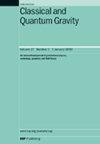庞特里亚金作用和边界项的几何分析
IF 3.6
3区 物理与天体物理
Q2 ASTRONOMY & ASTROPHYSICS
引用次数: 0
摘要
在本文中,我们采用不同的几何协变方法来分析庞特里亚金模型。特别地,我们聚焦于边界条件必须施加在描述体理论的场上的方式,以便在边界上重现定义良好的理论。在拉格朗日水平上,我们描述了理论的对称性,并构造了拉格朗日协变动量映射,它允许诺特定理的扩展。通过多辛分析,得到了规范群作用于协变多元相空间的协变动量图。通过适当束的叶化进行时空分解,我们不仅能够恢复理论的t-瞬时拉格朗日量和哈密顿量,而且还能够恢复规范变换的产生器。在多辛框架下,我们借助De Donder-Weyl hamilton量和Poisson-Gerstenhaber括号进行泊松-汉密尔顿分析。值得注意的是,只要我们考虑具有边界的背景流形,在所有这些几何公式中,我们都能够恢复所谓的可微条件,这些条件支持哈密顿函数是可微函数,这里作为诺特定理的直接结果得到。本文章由计算机程序翻译,如有差异,请以英文原文为准。
Geometric analysis for the Pontryagin action and boundary terms
In this article, we analyse the Pontryagin model adopting different geometric-covariant approaches. In particular, we focus on the manner in which boundary conditions must be imposed on the fields describing the bulk theory in order to reproduce a well-defined theory on the boundary. At a Lagrangian level, we describe the symmetries of the theory and construct the Lagrangian covariant momentum map which allows for an extension of Noether’s theorems. Through the multisymplectic analysis we obtain the covariant momentum map associated with the action of the gauge group on the covariant multimomenta phase-space. By performing a space plus time decomposition by means of a foliation of the appropriate bundles, we are able to recover not only the t-instantaneous Lagrangian and Hamiltonian of the theory, but also the generator of the gauge transformations. In the polysymplectic framework we perform a Poisson-Hamilton analysis with the help of the De Donder–Weyl Hamiltonian and the Poisson–Gerstenhaber bracket. Remarkably, as long as we consider a background manifold with boundary, in all of these geometric formulations, we are able to recover the so-called differentiability conditions which endorse the Hamiltonian as a differentiable function, here obtained as a straightforward consequence of Noether’s theorem.
求助全文
通过发布文献求助,成功后即可免费获取论文全文。
去求助
来源期刊

Classical and Quantum Gravity
物理-天文与天体物理
CiteScore
7.00
自引率
8.60%
发文量
301
审稿时长
2-4 weeks
期刊介绍:
Classical and Quantum Gravity is an established journal for physicists, mathematicians and cosmologists in the fields of gravitation and the theory of spacetime. The journal is now the acknowledged world leader in classical relativity and all areas of quantum gravity.
 求助内容:
求助内容: 应助结果提醒方式:
应助结果提醒方式:


